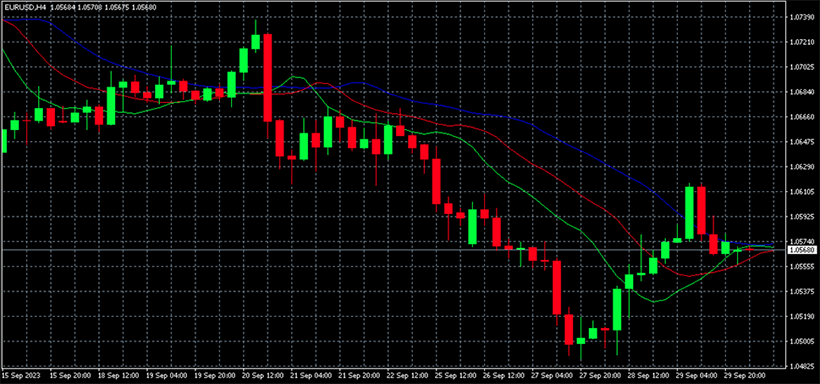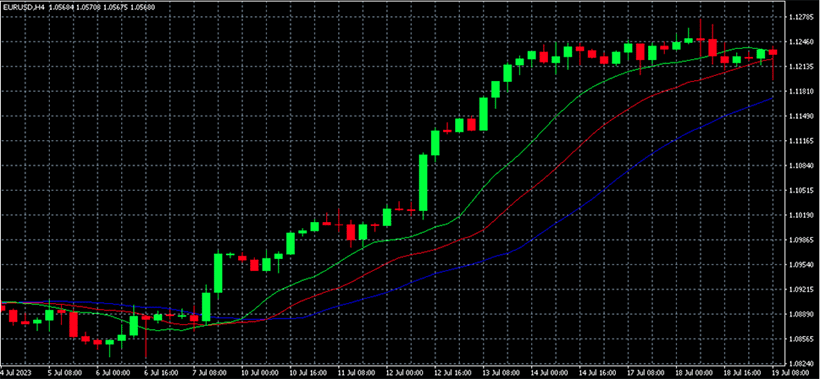
有经验的交易员知道可靠技术指标的重要性。它们指导我们的交易决策,帮助我们避免损失。在本文中我们将讨论的一个受欢迎的工具是威廉姆斯鳄鱼指标。它是在市场大部分时间不动的假设基础上创建的。这就是为什么清楚地了解新趋势何时出现至关重要。在这种情况下,鳄鱼指标可以非常有用。在本指南中,我们将讨论如何使用鳄鱼指标,它的起源,组成部分,优势和潜在缺点。
什么是鳄鱼指标?
该工具最初由比尔·威廉姆斯于1995年描述。它相当受欢迎,并包含在大多数终端的分析包中。您可以在MT4、MT5和其他热门平台上轻松找到它。尽管它很简单,但对交易员有一定的陷阱和巨大的潜力。
鳄鱼指标的组成部分

该指标由三条具有特定设置的曲线(移动平均线)组成。根据比尔·威廉姆斯的说法,原始的偏移和周期最能预测未来趋势的方向。您可以使用基本设置在图表上显示它,也可以根据您的鳄鱼交易策略进行调整。以下是MAs的默认设置:
- 绿线(鳄鱼嘴):周期5。向前偏移3个周期。
- 红线(鳄鱼牙齿):周期8。向前偏移5个周期。
- 蓝线(鳄鱼下颚):周期13。向前偏移8个周期。
很明显,绿色MA是最快的,最先对市场做出反应。现在,让我们更仔细地看看鳄鱼指标的组成部分。
下颚(蓝线)
蓝色MA(鳄鱼的下颚)是13周期移动平均线,向前移动8个柱。这是开始移动的最后一条线。当它偏离价格图表时,趋势很可能已经在增强。
牙齿(红线)
红色MA(鳄鱼的牙齿)是8周期平滑MA,向未来移动5个柱。这是更敏感的线,因此它比下颚早开始发散。
嘴唇(绿线)
最后一个MA(鳄鱼的嘴唇)是绿色的。周期为5,移动3个柱。这是最敏感的移动平均线,为交易员提供第一个信号。
鳄鱼指标背后的目的和理论
William鳄鱼指标得名于与捕食者的某些相似之处。三个移动平均线形成了类似鳄鱼的形状,有闭合的、稍微张开的或张开的嘴。这个生动的比喻使我们清楚地了解鳄鱼的情绪和意图。
当您看三个平滑的MA时,您可以看到鳄鱼的嘴或下颚。通常标记为蓝色线。较快的移动平均线(牙齿)为8周期,向未来移动5个柱。它是红色的。最短和最快的线称为鳄鱼的嘴唇。它是绿色的。这三条线共同完美展示了比喻鳄鱼的性格,并确定了未来市场的走势。
鳄鱼指标的工作原理

让我们用比喻来解释鳄鱼指标。当鳄鱼饱腹时,它会忽略当前的市场条件。此时,移动平均线交织在一起,因此很难区分它们。在鳄鱼休息时,横向趋势是市场最常见的状态。
我们如何看到鳄鱼正在挨饿? 当它开始狩猎时,嘴巴开始张开。 颚部张开,牙齿变得可见,嘴唇开始移动以捕捉食物。 在价格图表上,我们监视三条移动平均线的背离。 它们唤醒的顺序如下:嘴唇(绿线),牙齿(红线)和颚部(蓝线)。 具有最长周期(13根柱)的MA是最慢的。
随着鳄鱼变得更加饥饿,它的嘴巴张得更大。 这表示一种趋势。 线条分开,颚部与价格曲线越来越远。 趋势的结束在图表上有相反的表示。 线条彼此靠近并开始交织。 嘴巴闭上,鳄鱼正在等待下一次狩猎(趋势)时间。
计算鳄鱼指标
MetaTrader 4和其他交易平台使用简单的公式来计算鳄鱼指标。 通常,它们计算具有设置周期和偏移量的三个MA。 要手动执行此操作,您首先应确定每个柱的中间价格:
中间价格 =(最高价+最低价)/ 2。
下一步是计算线条:
颚部 = 平滑移动平均线(中间价格,13,8)。
牙齿 = 平滑移动平均线(中间价格,8,5)。
嘴唇 = 平滑移动平均线(中间价格,5,3)。
括号中的第二个数字表示周期,第三个数字表示偏移量。 您可以手动绘制线条,也可以使用特殊软件。 如果选择第二个选项,您将需要在菜单中找到指标并设置输入数据。
如何阅读和解释鳄鱼指标
“如何閱讀鱷魚指標?”這個問題並不難。它的簡單性使它成為外匯參與者中最受喜愛的工具之一。以下是您在圖表上可以看到的主要模式:
- 綠色MA高於紅色MA,紅色MA高於藍色MA。它們都向上指向。這是擴張市場的一個跡象。很可能是開倉多倉的好時機。
- 綠線在紅線下方,紅線在藍線下方,同時它們都向下指向。這種模式表明了一個看跌的趨勢。很可能您可以自信地開倉空倉。
- 線條交織或彼此接近。這是一個盤整期,最好停止交易並等待信號。
- 線條之間的分歧增加。這表明了趨勢的加強。
您還應該知道,鱷魚越久睡覺,它就越餓,未來的趨勢可能會更強勁。
使用鱷魚指標的交易策略
沒有一種Williams鱷魚交易策略。您可以將該工具用於不同目的並與其他工具結合使用。但是,您可以嘗試以下方法:
- 範圍交易。您可以在鱷魚指示的特定範圍內進行交易。
- 突破交易。價格突破範圍時的常見策略。
- 使用回調。您在先前位置附近開倉新倉。
- 尋找交叉點。當條形圖在三條線之下或之上關閉時,您可以進入市場。
如果您密切關注指標行為,檢查不同的時間框架並獲得額外的確認,則可以制定有效的鱷魚策略外匯。如果您對這種方法全心投入,它將持續改進。
鱷魚指標最佳設置
鱷魚指標顯示在價格圖上,由具有特定週期和偏移的三條移動平均線組成。它們通常具有默認設置。藍線週期為13,偏移為8。紅線週期為8,偏移為5。綠線週期為5,偏移為3。根據您的喜好,它們可以稍微增加或減少。 下一個重要因素是時間框架。最好在H24圖表及更高時間框架上使用鱷魚指標進行交易。儘管從理論上講,它可以在所有時間框架上運作,但不建議低於H4,或至少H1。在較短的時間框架上,該指標會產生許多虛假信號。 鱷魚指標的優點和限制 交易者可以通過使用Williams鱷魚指標獲得幾個優勢。以下是值得注意的主要好處: - 它提供了市場趨勢的清晰視覺表示,並且易於發現潛在的逆轉。 - 這個工具消除了短期波動,有助於識別強勁趨勢。 - 它提供了進入市場或持有倉位的簡單規則。 當然,這並不是一個完美的指標,它也有其局限性。例如,它無法在側向運動期間使用。在短時間框架上也不起作用。儘管如此,Williams鱷魚仍然是一個有用且常見的技術工具。 在外匯交易中使用鱷魚指標 現在您已經了解了該工具的一般原則,是時候了解如何在外匯交易中使用鱷魚指標了。以下是一些額外的提示,幫助您將這個飢餓的掠食者納入您的策略中:- 跟踪多个时间框架。这将使您能够更全面地了解市场。
- 考虑市场条件。探索当前情绪和其他因素。
- 将其与其他指标结合使用。始终使用更多技术工具以做出更精确的决策。
- 不断研究指标及其与价格的相关性。在不同的货币对上,其表现可能不同。
最后但同样重要的是:一致性和纪律是掌握任何技术指标的关键。继续努力以提高您的表现。
最重要的是
许多经验丰富的交易者认为外汇指标鳄鱼是他们交易工具包中的关键工具。它有助于准确识别趋势反转并改善交易结果。如果将该指标与自动化工具(如最佳外汇机器人)相结合,您甚至可以获得更多利润。使用它们可以避免手动工作并做出更准确的决策。









